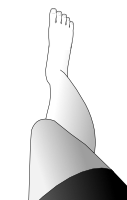Miserable malalignment is a specific combination of rotational deformities in the leg that may lead to patellar (kneecap) pain and instability.
 Page updated August 2023 by Dr Sheila Strover (Clinical Editor)
Page updated August 2023 by Dr Sheila Strover (Clinical Editor)

What is miserable malalignment?
In miserable malalignment usually the femur is rotated outwards, but the tibia rotated inwards, so the kneecaps face towards one another (squinting or winking patellae).
There is excessive force on the patella towards the lateral side. From the front, if the feet are aligned together the kneecaps appear to 'squint' towards one another, and if the kneecaps are aligned together, the feet are forced to turn outwards.
-
Quote from peer-reviewed paper:
"....the high degree of individual variability in terms of combinations of and differences in risk factors....makes it difficult to accurately isolate the roles of these factors in contributing to patellar dislocation...."
Citation: Balcarek P, Radebold T, Schulz X, Vogel D. Geometry of Torsional Malalignment Syndrome: Trochlear Dysplasia but Not Torsion Predicts Lateral Patellar Instability. Orthop J Sports Med. 2019 Mar 15;7(3):2325967119829790. doi: 10.1177/2325967119829790. PMID: 30906795; PMCID: PMC6421616.
-
Quote from peer-reviewed paper:
"....Currently, a clear consensus has not been reached regarding the torsion threshold to indicate surgical correction. In recent studies, the mean extent of torsional correction ranged from 11° to 25° for the femur and from 11° to 36° for the tibia. Therefore, torsional osteotomy might be considered in symptomatic patients with an increase in femoral or tibial torsion of at least 10° above normative values....."
Citation: Balcarek P, Radebold T, Schulz X, Vogel D. Geometry of Torsional Malalignment Syndrome: Trochlear Dysplasia but Not Torsion Predicts Lateral Patellar Instability. Orthop J Sports Med. 2019 Mar 15;7(3):2325967119829790. doi: 10.1177/2325967119829790. PMID: 30906795; PMCID: PMC6421616.
Symptoms associated with torsional deformity affecting the knee
Symptoms causing alarm in patients with torsional deformity around the knee include patellar instability (with subluxation or dislocation events) or anterior knee pain (pain at the front of the knee.
Previous dislocations may have resulted in tears of the medial patellofemoral ligament (MPFL), which will make the patient even more susceptible to instability.
Associated trochlear dysplasia, with a flattened groove under the patella, or a high-riding patella alta, will further aggravate the situation.
However, a patient may be asymptomatic, concerned only with physical appearance, and such patients are usually referred to cosmetic orthopaedic units.
How is miserable malalignment managed?
Most cases are managed without surgery. Surgery, when indicated, is usually a de-rotation osteotomy of femur, tibia of both.
Options may include plating of the bones, or an external fixator where pins are inserted into the bones through the skin and gradual adjustments are made to the rotation as the bone breaks heal with callus.
-
Quote from peer-reviewed paper:
"....The results show that double level torsional osteotomy is an effective treatment option for patients with patellar dislocation or subluxation associated to torsional deformities of femur and tibia. The patients achieved joint stability through the procedure....."
Citation: Liße J, Perl M, Dickschas J. Double-level torsional osteotomy a treatment for the 'inwardly pointing knee' syndrome. Arch Orthop Trauma Surg. 2023 Jun;143(6):2863-2875. doi: 10.1007/s00402-022-04446-w. Epub 2022 May 12. PMID: 35551448; PMCID: PMC10191926.
-
Quote from peer-reviewed paper:
With regard to external fixators "....the time in the frame may offer an opportunity for the patient to adapt to walking with the patella pointing forwards, as most will have walked with the patella squinting inwards for many years...[but] there are difficulties associated with using an external fixator, such as pin site infection and soft tissue tethering, and the social and psychological implications of having a frame on a limb for several months...."
Citation: Elsheikh AA, Cross GWV, Wright J, Goodier WD, Calder P. Miserable malalignment syndrome associated knee pain: a case for infra-tubercle tibial de-rotation osteotomy using an external fixator. J Orthop Surg Res. 2023 Oct 11;18(1):768. doi: 10.1186/s13018-023-04252-z. PMID: 37817247; PMCID: PMC10566009.
Forum discussions
- Success with TTT or Derotation for Severe Miserable Malalignment?
Talking about outcomes of surgeries in cases of miserable malallignment.
See also -
 2008 - reviewed 2023 - Patellofemoral pain - by Dr Ronald Grelsamer (Knee Surgeon)
2008 - reviewed 2023 - Patellofemoral pain - by Dr Ronald Grelsamer (Knee Surgeon)
 2014 - Rotational Deformity & Miserable malalignment - by Professor Adrian Wilson (Knee Surgeon)
2014 - Rotational Deformity & Miserable malalignment - by Professor Adrian Wilson (Knee Surgeon)
 2014 - Rotational Deformity ("Miserable Malalignment") - by Dr Mark Sanders (Knee Surgeon)
2014 - Rotational Deformity ("Miserable Malalignment") - by Dr Mark Sanders (Knee Surgeon)